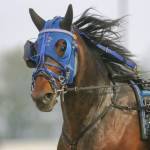Mares and Muscle Disease: Is Estrous Cycle a Factor?

According to several studies and anecdotal reports, mares are more likely to suffer from exertional rhabdomyolysis than geldings or stallions, yet researchers cannot pinpoint why sex might be a risk factor for this disease. Could a correlation exist between exertional rhabdomyolysis and the estrous cycle?
European researchers evaluated the changes in muscle enzyme activities in mares affected by exertional rhabdomyolysis compared to control mares before and after typical exercise and the correlation of such changes with the stage of the estrous cycle and sex hormone fluctuations.*
Researchers used 20 Standardbred race mares with regular estrous cycles in a four-week study. Ten mares had experienced at least two bouts of mild to moderate rhabdomyolysis in the previous training season but none in the preceding month. Disease signs in these mares were characteristic: sweating, discomfort, stiffness, reluctance to move, and muscle pain in the hindquarters. Clinical diagnosis was made based on elevated levels of aspartate aminotransferase (AST) and creatine kinase (CK). The other 10 mares had no signs of muscle disease and were designated as controls. Serum muscle enzyme activity before and after exercise and sex hormones were analyzed in both sets of mares.
In sum, the researchers found “that AST activities in mares with exertional rhabdomyolysis are always higher than those in control mares, except for pre-exercise activities during estrus. Hence, far from being a conclusive study, results suggest that sex hormones may play a different role in horses predisposed to exertional rhabdomyolysis.”
While researchers continue to contemplate why racehorse fillies and mares are more susceptible to exertional rhabdomyolysis, it is important to nourish affected horses in a way that undergirds both performance and muscle health.
“Forage should be the foundation of every feeding program, so it is important to establish both the type and expected intake of forage before choosing concentrates or supplements,” said Catherine Whitehouse, M.S., a nutrition advisor at Kentucky Equine Research. “For racehorses with high energy needs and a propensity for gastric ulcers, alfalfa may be the best choice.”
In selecting a concentrate for horses with recurrent exertional rhabdomyolysis (RER), substitution of fat for nonstructural carbohydrates (NSC) as an energy source has proven beneficial.
“Current feeding guidelines suggest that NSC should provide no greater than 20%, and fat should provide between 20% and 25%, of daily digestible energy intake for optimal management of RER horses,” explained Whitehouse.§
The benefit of a high-fat diet for RER horses does not, however, appear to be a change in muscle metabolism. Instead, low-starch, high-fat diets may decrease muscle damage by tempering anxiety and excitability, which coincide with the onset of rhabdomyolysis in susceptible horses. Low-starch, high-fat diets led to a calmer demeanor and lower post-exercise heart rates.+
Feeding high-performance horses with exertional rhabdomyolysis requires an understanding of both the disease and the nutritional requirements of the individual horses, especially when faced with high-strung fillies and mares.
*Pasolini, M.P., R. Pezzella, P. Santoro, N. Cocchia, M. Greco, C. Del Prete, G. Della Vale, and L. Auletta. 2020. Correlation between serum activity of muscle enzyme and stage of the estrous cycle in Italian Standardbred horses susceptible to exertional rhabdomyolysis. Journal of Equine Veterinary Science 92:103175.
§McKenzie, E.C., S.J. Valberg, S.M. Godden, J.D. Pagan. J.M. MacLeay, R.J. Geor, and G.P. Carlson. 2003. Effect of dietary starch, fat, and bicarbonate content on exercise responses and serum creatine kinase activity in recurrent exertional rhabdomyolysis. Journal of Veterinary Internal Medicine 17:693-701.
+Finno, C.J., E.C. McKenzie, S.J. Valberg, and J.D. Pagan. 2010. Effect of fitness on glucose, insulin, and cortisol responses to diets varying in starch and fat content in Thoroughbred horses with recurrent exertional rhabdomyolysis. Equine Veterinary Journal Suppl. 42:323-328.








